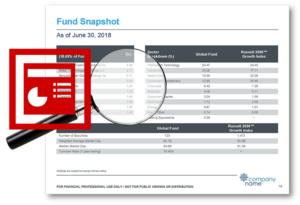Is Now the Time to Automate?

In today’s fast-paced, tech-driven environment, investment product marketers can’t really afford to dismiss document automation as just a “nice to have”. Marketing departments at investment management companies of all sizes are increasingly utilizing automation to improve productivity and mitigate risk. Good marketers in any industry plan for the future to ensure that their operations scale in pace with their growing business. Similar to their colleagues, to remain competitive, investment product marketers must be strategic. They must determine how to effectively use automation to produce key sales support materials such as fund fact sheets, commentaries and website content — and it’s important to get the timing right.
There are typically three key indicators that your firm should start seriously considering a marketing production automation solution:
- You’re marketing 14 products or more
- Your current process can’t keep pace with demand
- Your data processes have become unwieldy—and risky
You’re marketing 14 products or more
One of the true markers of automation readiness is your product count.
- How many products are you marketing?
- How will this count increase over the next 24 months?
In my experience, firms can usually justify the cost of a good document automation program once they hit 14 products or so. Below this count, the literature production process is probably manageable with traditional manual techniques.
Even with 14 products, though, marketing leadership is still going to have to sell management on the idea of automation. You’ll have to make the business case to show your executive that “if we’re going to grow, we need to get these processes up to speed now—ahead of time.” If you do this successfully, everyone is going to be happy they made the move in advance, especially by the time your firm is offering 20 products or more.
This is a justifiable inflection point in how your marketing team is likely to operate. By the time a product menu features 14 items, an investment management firm has essentially made the commitment to become a player in the industry. The rationale for making such a commitment is clear: you’re seeking market attention (and share) by offering an increasingly broad spectrum of investment options. You’re bringing your pedigreed process and skill set to a diverse consumer base of financial advisors and their clients… whether retail, intermediary or institutional. An investment firm doesn’t usually get past 14 products without having taken this significant step toward market visibility.
Your current marketing process can’t keep pace with demand
Once your company has made the commitment to expand its menu, the product marketing team is on the hook to not only provide all the collateral needed to support the burgeoning sales effort, but to do so in a timely manner. You’ll need a sound process in place to ensure that marketing efforts are truly supporting the firm’s growth plans. Real and scalable tools—such as document automation tools—need to be put in place to support your firm’s step into the limelight. Consider:
- How many different types of documents are you currently producing?
- How might this variety of documents change over the next year?
- What is the customization strategy for your sales force?
- What are your multi-language requirements, if any?
The truth is that the volume and variety of marketing literature produced to support the sales of financial instruments is on the rise. Firm websites are designed to present a variety of product information tailored to a wide variety of clients. However, the traditional sales process fueled by people and documents remains a critical component of the marketing strategy. Literature—not just HTML—must be produced to preserve the human connection (this can—and should—be a strong value add for your business).
We frequently see companies producing three, four, even five different document sets for each product in its lineup:
- Fact sheets – still the staple of the industry after all these years
- Commentaries – becoming almost as common as fact sheets, providing valuable thought leadership and talking points
- Sales ideas and focus fund pieces – documents presenting a blend of fact sheet and commentary information, usually targeting large asset and/or top-performing products
- Performance guides – tabular organization of vital facts and figures for the entire product line (often produced monthly as a supplement to fact sheets)
- Pitchbooks – presenting information overlapping with all of the above categories but organized and formatted for an in-person sales visit (often used as valuable leave-behinds as well)
As the sophistication of your marketing initiative grows, so does your literature set. Today we see firms working on plans to identify, segment and target their clients by multiple and intersecting characteristics. Based on those results, product marketers then develop tactics to produce custom literature supporting virtually all clients across all distribution channels, wherever they happen to be in their buying process. Moreover, account-based marketing strategies are magnifying marketing communication efforts.
The challenge here is to support this proliferation of literature in a manner that doesn’t compromise standards or eclipse the available time and resources for preparing the materials.
Toward that end, the data exhibits supporting these different types of literature need to be consistent and correct, and the methods for producing the literature need to be uniform. Each document set needs to be unique, tuned for their purpose and audience, yet easy to produce and proof. This is where a true data-driven automation strategy becomes a veritable necessity.
If your marketing collateral mix is moving in this direction, stop and get your process and tools in place before charging ahead. You’ll be very glad you did.
Your data processes have become unwieldy—and risky
Data can be the single most significant factor in driving up costs and extending timelines for producing financial marketing literature.
Companies—large and small—struggle with collecting, validating and formatting data for public consumption. In fact, with the increasing complexity of today’s investment products such as strategies, SMAs and alternatives, and the resulting increase in the use of third-party sub-advisors specializing in such creative construction, the data aggregation problem has grown more and more challenging.
Small firms face additional hurdles because they’re less likely to invest in major infrastructure and develop a real data warehouse. Most small firms find themselves with an interesting collection of spreadsheets used to collect and pre-prepare data for publication. Sometimes these spreadsheets are works of genius; sometimes they are a train wreck. In both cases, they represent a significant opportunity for risk and a bottleneck in the process. That said, many data warehouses at large firms are also incomplete and poorly designed in relation to the needs of the marketing and communication groups. This issue—and risk potential—only escalates as a company expands.
The data dilemma can be tackled either separately or as part of a document automation project. We recommend the latter option. The problem with addressing data challenges in isolation is that the use-case for the data (i.e. the final presentation and delivery need) is easily ignored. On multiple occasions we’ve seen a firm’s internal data warehouse provide little process or timeline improvement for the product marketing team. Those databases are certainly an improvement over the spreadsheet paradigm, but the final goals of efficient processes and competitive time-to-market were still missed.
Key signals that document automation may be in order to address data concerns include:
- If your marketing group is collecting, cleaning up and checking data from more than a dozen data sources, you are probably well qualified for a data automation effort and will see a real ROI from the project.
- If there is one key individual in marketing or product management who is manually maintaining a huge and complicated data roll-up and pre-calculation spreadsheet, you are ready for something more sophisticated.
- If your data arrives in disparate and uncontrolled formats and humans need to take it apart and “clean it up” for marketing use, there are solutions for you, too.
Conclusion
The first step toward document automation is analyzing where you are and where you’re going. Getting an automation solution in place before you experience a scaling roadblock is the key to meeting your ever-increasing literature and data needs. If you’re thinking about document automation but aren’t sure when or how you should start, I’d be happy to setup a time to walk you through it. Just shoot me an email.







 Compare the Top 3 Finserv Content Automation Vendors [White paper]
Compare the Top 3 Finserv Content Automation Vendors [White paper] Create Pitchbooks the Drive Sales [White paper]
Create Pitchbooks the Drive Sales [White paper] Build vs. Buy: Should Your Financial Services Firm Outsource or Insource Marketing Technology? [White paper]
Build vs. Buy: Should Your Financial Services Firm Outsource or Insource Marketing Technology? [White paper]  10 Tips for Rebranding your Fund Marketing Documents [White paper]
10 Tips for Rebranding your Fund Marketing Documents [White paper]



